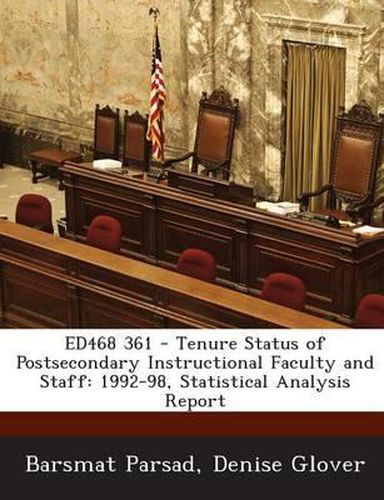Readings Newsletter
Become a Readings Member to make your shopping experience even easier.
Sign in or sign up for free!
You’re not far away from qualifying for FREE standard shipping within Australia
You’ve qualified for FREE standard shipping within Australia
The cart is loading…






Using data from the National Study of Postsecondary Faculty: 1993 (NSOPF:93) and the NSOPF of 1999 (NSOPF:99), this study focused on changes in the tenure status of full-time instructional faculty and staff at two- and four-year institutions between fall 1992 and fall 1998. It analyzed changes in tenure status by level and control of institution, program area, and the faculty’s academic rank, gender, and race/ethnicity. These analyses are based on instructional faculty and staff, those with some for-credit teaching responsibilities. Data from the first 2 cycles of NSOPF show that the proportion of full-time instructional faculty and staff with tenure at postsecondary institutions decreased from 58% in 1987 to 54% in fall 1992. More recent NSOPF:99 data indicate that across all postsecondary institutions, 53% of full-time instructional faculty and staff were tenured in the fall of 1998. Another 19% were on the tenure track, but not tenured. Faculty who taught at four-year institutions were more likely to be on tenure track than those who did not. The gender gap was apparent in both 1992 and 1998, with male faculty more likely to have tenure (61% versus 40% of females). As did previous studies, NSOPF:99 found racial and ethnic differences in tenure status among full-time instructional faculty and staff. White, non-Hispanic faculty members were more likely to have tenure in four- year, but not two-year, institutions. Three appendixes contain technical notes, tables of standard errors, and a glossary. (Contains 15 tables, 4 figures, and 14 references.).
$9.00 standard shipping within Australia
FREE standard shipping within Australia for orders over $100.00
Express & International shipping calculated at checkout
Using data from the National Study of Postsecondary Faculty: 1993 (NSOPF:93) and the NSOPF of 1999 (NSOPF:99), this study focused on changes in the tenure status of full-time instructional faculty and staff at two- and four-year institutions between fall 1992 and fall 1998. It analyzed changes in tenure status by level and control of institution, program area, and the faculty’s academic rank, gender, and race/ethnicity. These analyses are based on instructional faculty and staff, those with some for-credit teaching responsibilities. Data from the first 2 cycles of NSOPF show that the proportion of full-time instructional faculty and staff with tenure at postsecondary institutions decreased from 58% in 1987 to 54% in fall 1992. More recent NSOPF:99 data indicate that across all postsecondary institutions, 53% of full-time instructional faculty and staff were tenured in the fall of 1998. Another 19% were on the tenure track, but not tenured. Faculty who taught at four-year institutions were more likely to be on tenure track than those who did not. The gender gap was apparent in both 1992 and 1998, with male faculty more likely to have tenure (61% versus 40% of females). As did previous studies, NSOPF:99 found racial and ethnic differences in tenure status among full-time instructional faculty and staff. White, non-Hispanic faculty members were more likely to have tenure in four- year, but not two-year, institutions. Three appendixes contain technical notes, tables of standard errors, and a glossary. (Contains 15 tables, 4 figures, and 14 references.).